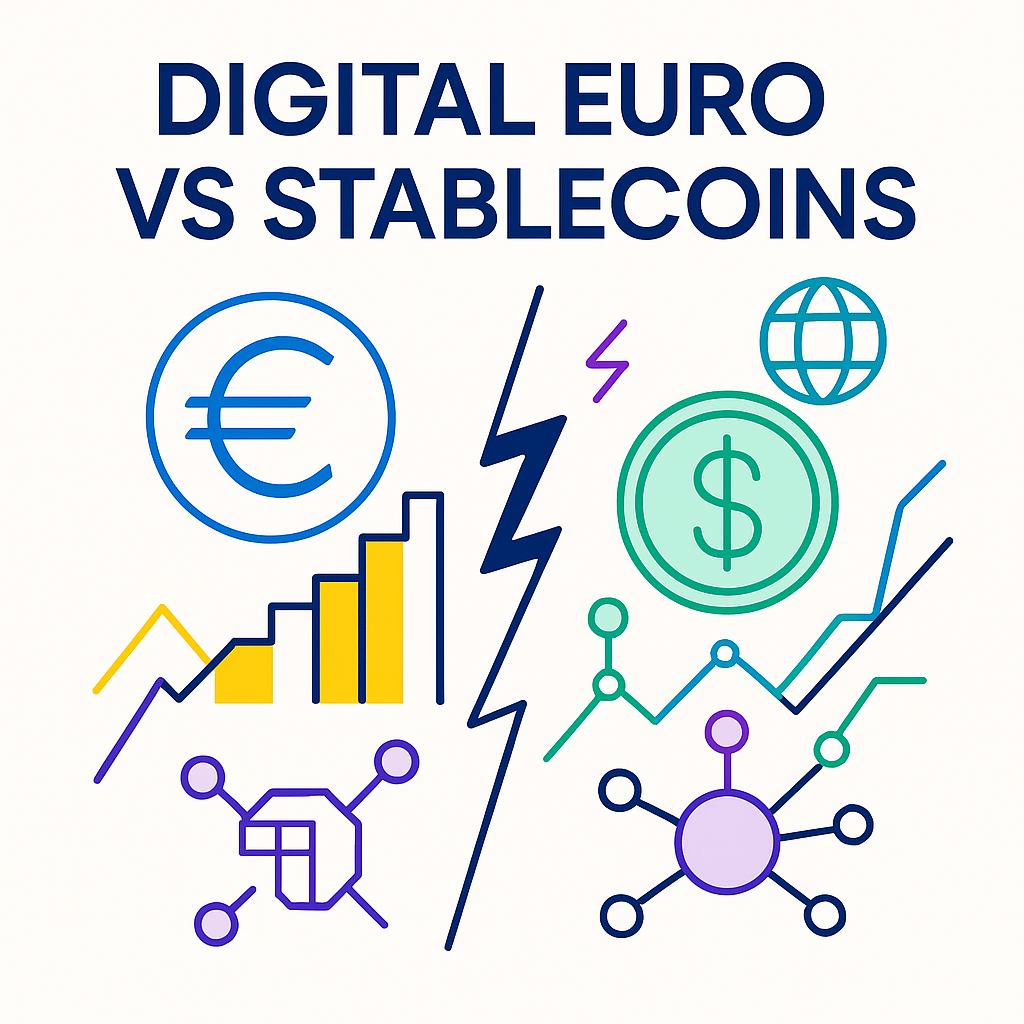Digital Euro Public Blockchain Adoption 2025: Can the EU Counter U.S. Stablecoin Dominance After the GENIUS Act?
The EU is accelerating its digital euro strategy after the U.S. GENIUS Act boosted dollar stablecoins. Explore how public blockchain adoption in 2025 could redefine financial sovereignty.
Key Takeaways
• The U.S. GENIUS Act strengthened the dominance of dollar-backed stablecoins.
• The EU is considering digital euro public blockchain adoption in 2025 to counterbalance.
• Goals include sovereignty, privacy, and sustainable payment infrastructure.
• The ECB will decide in October 2025 on the future design of the digital euro.
• Key risks: banking stability, data privacy, and international regulation gaps.
In July 2025, the U.S. passed the GENIUS Act, establishing a regulatory framework for the $288 billion stablecoin market (FT). Almost all of these tokens are tied to the U.S. dollar, reinforcing its dominance in global finance.
For Europe, this was a wake-up call. The EU began accelerating its digital euro strategy, with growing discussions around public blockchain adoption in 2025. Policymakers argue that without a strong response, U.S. stablecoins could overshadow the euro in the digital era.
The Digital Euro Project: Origins and Strategic Shifts
The European Central Bank (ECB) launched its digital euro investigation in 2023 and moved into the preparation phase by 2024. Work focused on technical rulebooks and user experience design (ECB).
The turning point came in 2025 with the GENIUS Act. By legalizing and regulating dollar stablecoins, the U.S. secured a major first-mover advantage. In response, the ECB set October 2025 as the deadline to decide on critical features, including whether the digital euro should embrace public blockchain adoption to ensure competitiveness.
Global Stablecoin Market: Data and Dollar Dependence
The global stablecoin market stands at about $255 billion, with over 99% pegged to the U.S. dollar. This concentration highlights how dependent Europe’s payment systems are on American infrastructure.
In the eurozone, more than 60% of card transactions rely on U.S. card networks. Without intervention, analysts warn, dollar-backed stablecoins could entrench this imbalance, limiting the euro’s role in cross-border finance. This explains why EU CBDC strategy after the GENIUS Act has become a political and economic priority.
Expert Views on the Digital Euro’s Potential
Experts emphasize that the digital euro could reshape Europe’s financial architecture.
- The Financial Times noted that dollar stablecoin dominance could erode Europe’s financial sovereignty.
- Cointelegraph highlighted how digital euro public blockchain adoption in 2025 could unlock “programmable money,” enabling smart contracts and digital asset ecosystems.
- Policy analysts argue the ECB’s October decision will be decisive for Europe’s ability to compete in fintech innovation.
Implications for Europe’s Economy and Industry
The rollout of a digital euro would have broad ripple effects:
- Sovereignty: A digital euro would reduce reliance on U.S. payment rails.
- Innovation: If built on Ethereum or Solana, the EU could lead in blockchain technology.
- Market Opportunities: Fintech and blockchain startups could benefit from new infrastructure.
- Risks: Bank deposits may migrate to CBDCs, raising financial stability concerns. Privacy protection and regulatory alignment also remain challenges.
Here, EU CBDC strategy after the GENIUS Act isn’t only defensive—it is also about building a forward-looking digital economy that balances sovereignty and innovation.
What’s Next: The ECB’s October 2025 Decision
The ECB’s October 2025 decision is the next milestone. Key questions include whether to adopt a decentralized architecture, how to safeguard privacy, and how to protect banking stability.
Over the next two to three years, Europe will need to pass supporting legislation, build infrastructure, and collaborate internationally. Investors see opportunities in privacy tech, cybersecurity, and payment UX design.
Ultimately, digital euro public blockchain adoption in 2025 could mark the EU’s boldest step to compete with U.S. stablecoins.
The digital euro is not just a central bank digital currency—it is Europe’s strategic response to the growing dominance of dollar-backed stablecoins. The GENIUS Act gave the U.S. a head start, but the EU’s embrace of public blockchain adoption in 2025 could tilt the balance.
The ECB’s October decision may redefine Europe’s role in global finance for the next decade.







